A New Material Based on Clay and its Successful Application to Fix the Glucose
Boumethred Torkia1,2*, Bengueddach Abedelkader1 and Haouzi Ahmed2
1Chemistry materials laboratory, University of Ahmed Benbella Oran 1, 31000, Algeria.
2Synthesis and Catalysis Laboratory, University of Ibn Khaldoun Tiaret,14000, Algeria.
Corresponding Author E-mail: boumetred@yahoo.fr
DOI : http://dx.doi.org/10.13005/ojc/330145
The aim of the present study is to seta new material based on clay and its application to fix the glucose.Montmorillonite KSF-Fe2+ were prepared by varying the exchange time (3h, 8h, and 11h). These samples were identified as FM3, FM8,and FM11, respectively. Glucose level was determined using the enzymatic reaction. The adsorption kinetic of glucose, by the studied samples, showed that the FM8 gives a better fixation of glucose (40,5%). Characteristics of the samples were studied by X-ray diffraction (XRD), Fourier transform infrared spectroscopy (IR) ,thermogravimetry (ATG) and Mossbauer spectroscopy. The X-ray diffraction (XRD) afforded the slight evolution of the interlayer distance d001 during cation exchange .The IR spectrum of FM8-G( Material loaded with glucose) show appearance of new band at 1150cm-1 correspond to nC-O and Another band located around 1420 cm -1 is assigned d CH2+d OCH+dCCH. Thermogravimetric analysis(TGA) confirms the binding of glucose there is a loss of weight around 350°C and 410 °C corresponds to the decomposition of the glucose. The study of the MÖssbauer spectrum of FM8 were carried out the state of oxidation of ferrous ions in montmorillonite structure. This result could confirm that the fixation of glucose was achieved successfully
KEYWORDS:MontmorilloniteKSF; ferrous ion; adsorption; glucose
Download this article as:| Copy the following to cite this article: Torkia B, Abedelkader B, Ahmed H. A New Material Based on Clay and its Successful Application to Fix the Glucose. Orient J Chem 2017;33(1). |
| Copy the following to cite this URL: Torkia B, Abedelkader B, Ahmed H. A New Material Based on Clay and its Successful Application to Fix the Glucose. Orient J Chem 2017;33(1). Available from: http://www.orientjchem.org/?p=28458 |
Introduction
There are a wide variety of argillaceous rocks, depending on their structure and mineralogical composition, of which only few are used in medical therapy1. Each of these clays can, very often, shows some specific therapeutic virtues.Although they present in general a number of similar properties that characterize them.
The montmorillonitestudied in the present work are of colloidal clays 2, which received multiple applications, dueto their high exchange capacity and swelling as well as their rheological properties (thixotropy) 3. They are therefore used in various fields such as drilling, foundry, ceramics, pharmacy, … etc.
In the present studywe aimed to use a material and a compensating cationin which the retention of glucose is the most important (KSF-Fe2+). The kinetics of contact between clayand solutions of glucose was investigated to search for an optimal time giving a better retention. In this article, the results obtained by the combined use of X-ray diffraction, IR, thermal analysis and Mossbauer spectroscopy are described. These analyses were carried out with the objective of determining the state of the iron in montmorillonite structure, and to characterize the interaction between montmorillonite exchanged By ferrous ions and glucose.
Experimental section
Preparation of the adsorbents
All experiments in this work were carried out on a same bacthof montmorillonite KSF supplied by Aldrich.It is a commercial montmorillonite, calcium-rich form of gray powder.
The mass ratios of oxides of the elements forming this clay are given in Table 1.
Table 1: Chemical composition (in wt%) of montmorillonite KSF4
| Oxide | Al2O3 | SiO2 | Na2O | MgO | P2O5 | K2O | CaO | TiO2 | MnO | Fe2O3 |
| ٪ | 14.93 | 69.31 | 0.14 | 2.19 | 0.09 | 1.17 | 2.08 | 0.44 | 0.01 | 3.97 |
The exchange by Fe2+
The cation exchange Fe2+was selected based on its capacity to form a complex with glucose.
In order to investigate the potential fixation of glucose, three materials referenced as FM3, FM8 and FM11wereprepared and subjected to a cation exchange with ferrous ions by varying the exchange time asindicated in following chart (Fig.1).The studied materials were then characterized.
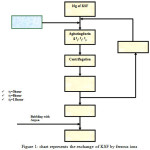 |
Figure 1: chart represents the exchange of KSF by ferrous ions |
Determination of glucose
The determination of glucose was achieved by an enzymaticmethod reaction, as described previously 5,6. The assessmentswere performed using a spectrophotometer (Shimadzu Corporation, Japan 1200 UV). The peak wavelengths were obtained directly by an automatic scanning between 200 to 800 nm.
Principle
Glucose is oxidised to gluconic acid and hydrogen peroxide in the presence of glucose oxidase. Hydrogen peroxide further reacts with phenol and 4-aminoantipyrine by the catalytic action of peroxidase to form a red colouredquinoneimine dye complex. Intensity of the colour
formed is directly proportional to the amount of glucose present in the sample7,8,9.


Procedure
Wavelength: 505 nm
Temperature: 37°C
Light path: 1cm
| Addition Sequence | Blank(ml) Standard Test |
| Glucose Reagent (L1) | 1(ml) 1(ml) 1(ml) |
| Distilled water | 1(µl) – – |
| Glucose standard | – 1(µl) – |
| Sample | – – 1(µl) |
Mix well and incubate at 37°C for 10 mins,
Measure absorbance of the Standard (Abs.S) and Test Sample (Abs.T)
Calculations
Abs.T
Total Glucose in mg/dl = ———— x 100
Abs.S
Cinétique adsorption
It was necessary to follow the kinetics of the adsorption of glucose to determine the conditions for maximal binding. For this, three suspensions containing 250ml of glucose solution at 2 g/l and 1.5g FM3,FM8 and FM11, were kept under stirring followed by a centrifugation at 4500rpm/min then assayed as described above.
Results and discussion
Adsorption kinetics
As shown in the (Fig 2), the maximum adsorption rate for the three materials used ( FM3, FM8, and FM11) are 23.5%, 40.5% and 29.5%, respectively.
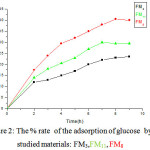 |
Figure 2: The % rate of the adsorption of glucose by the studied materials: FM3,FM11, FM8 |
Interestingly, the FM8 material, prepared using Fe(II) exchanged montmorillonite KSF for an exchange time of 8 hours gives an adsorption rate of 40.5% glucose, which is much higher when compared to those obtained with the other two materials (FM3 and FM11).
Characterization by XRD
Powder pattern where recorded on a PHILIPS X’Pert MPD θ-θ diffractometer equipped with the X’Celerator detector with Cu Kα radiation (λ = 1.5418 Å) and nickel filter »The different results regarding the XRDcharacterization of the studied samples
are summarized in the Fig.3. Examination of this recorded diffractogram and peak list show that the basic structure of the aluminosilicates is maintained and the values of angle are bandsq2 Characteristics of montmorionite. It seems clearly that the distance d001 of exchanged montmrillonite by ions ferrous affected a slight change in the inter-fowl distanceafter the fixation of glucose.
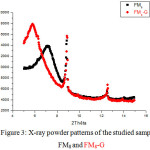 |
Figure 3: X-ray powder patterns of the studied samples FM8 and FM8-G |
Characterization by IR
The use of infrared spectroscopy allows determininginformation about the different absorption bands existing in the material FM8-G. The IRTF spectrum examination (Fig. 4) shows the following bands: An intense strip at 3450 cm -1 and a strip at about 1630 cm -1; Are relative to the modes of vibration of the water molecules adsorbed in the inter-sheet space 10,11,12, the bands located around 1050 cm -1 and 910 cm -1 and 840 cm -1 are assigned respectively to the “Elongation of the Si-O bond; The deformation of the Al-Al-OH bond and the deformation of the Al-Mg-OH bond, the band located around 780 cm-1 is due to the elongation vibration of the bond Si-O bond13,14, we noticed an appearance of new band at 1150cm-1 correspond tonC-O and Another band located around 1420 cm -1 is assigned d CH2+d OCH+dCCH.
This result could confirm that the fixation of glucose was achieved successfully.
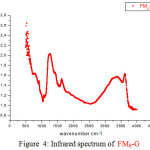 |
Figure 4: Infrared spectrum of FM8-G |
Thermal gravimctric analysis
The process of weight loss can be devised two stapes the firstweight loss observed Around 100 °C is attributed to the desorption of water ( with may be physical or chemical adsorption on the interpaticle surface of two samples (FM8 and FM8-G), the second stap from 560 to 600 °C with the main weight loss can correspond to the weight loss caused by breaking the Calcite15. In the sample FM8-Gthere is a loss of weight around 350°C and 410 °C corresponds to the decomposition of the glucose.
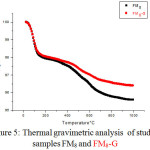 |
Figure 5: Thermal gravimetricanalysis ofstudied samples FM8 and FM8-G |
Mossbauer analysis
A typical Mossbauer spectrum of FM8 is shownin(Fig. 6), whereas the computer-fitted parametersfor the sample studied are given in Table 3.
Iron is present in 5 forms, 2 Fe2+ kinds (15%) and 3 types of Fe3+ (85%)
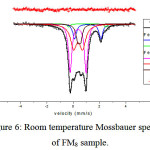 |
Figure 6: Room temperature Mossbauer spectrum of FM8 sample. |
Table 3: Mossbauer parameters at room temperature of FM8
| FM8 | IS, mm/s | QS, mm/s | LW, mm/s | Contribution % | ||||||||
| Comp1 | 1.09 | ± | 0.02 | 2.00 | ± | 0.03 | 0.32 | ± | 0.03 | 13 | ± | 5 |
| Comp2 | 1.06 | ± | -1.00 | 2.82 | ± | -1.00 | 0.23 | ± | -1.00 | 2 | ± | -1 |
| Comp3 | 0.36 | ± | 0.00 | 1.21 | ± | 0.01 | 0.30 | ± | 0.02 | 38 | ± | 5 |
| Comp4 | 0.36 | ± | 0.01 | 0.68 | 0.07 | 0.56 | ± | 0.06 | 34 | ± | 7 | |
| Comp5 | 0.44 | ± | 0.01 | 0.22 | ± | 0.03 | 0.31 | ± | 0.08 | 12 | ± | 4 |
Conclusion
This study describes the preparation of a new material based on clay: montmorillonite Fe2+ shows a high percentages of glucose capture.
The results showed an important adsorption of glucose (around 40,5%) with compensating cation (Fe (II) – KSF) at 8 hours where the exchange of montmorillonite KSF with ferrous ions. ), this sample is identified as FM8.
The use of infrared spectroscopy allows determining informations about the different absorption bands existing, appearance of new band at 1150cm-1 correspond to nC-O and Another band located around 1420 cm -1 is assigned d CH2+d OCH+dCCH.
The t Thermogravimetric analysismakes it possible to follow the loss of mass of the sample as a function of the temperature, In the sample FM8-Gthere is a loss of weight around 350°C,380°C and 410 °C corresponds to the decomposition of the glucose
Mossbauer spectroscopy were carried out the state of oxidation of ferrous ions in montmorillonite structure.
This result could confirm that the fixation of glucose was achieved successfully.
References
- Crretero,M. I. Clay minerals and Their beneficial upon human health. Appl. Clay Sci. 200,21,155-163
CrossRef - Carrere, A. PhD thesis.University Joseph Fourier of Grenoble (UJF).2002
- Morel,R.Cultivatedsoils. Lavoisier, Paris. 1996
- Cooper,C.; Jiang,J.Q.;OukiS. Preliminary assessment of polymeric Fe-and Al-modified clays as adsorbents for heavy metal removal in Water Treatment.J ChemTechnolBiotechnol.2002,77, 546-551.
CrossRef - MalleinRodier, J. R. Handbook of Biochemistry practice.1973 , 197
- Albert L.Lehninger, Biochemistry “Molecular basis of cell structure functions” end Ed Flammarion Medicine-Sciences. 1977
- Trinder, P. Determination of Glucose in Blood using Glucose Oxidase witha alternative oxygen acceptor .Ann.Clin. Biochem.1969,6, 24-27
CrossRef - Stahil, M.; Jorgensen, LGM.;HyltoftPetersen,P.Optimization of preanalytical conditions and analysis of plasma glucose. 1. Impact of the new WHO and ADA recommendations on diagnosis of diabetes mellitus. Scand. J. Clin. Lab. Invest.2001, 61, 169-180
CrossRef - Boyanton, B.L. Jr.; Blick, K.E. Stability studies of twenty-four analytes in human plasma and serum.Clin.Chem. 2002,48, 2242-2247
- Janice,L.; Bishop. Infrared spectroscopic analyses on the nature of water in montmorillonite .Clays and Clay Minerals, 1994, 42,702-716
CrossRef - MurrayH, H. Bentonite, Palygorskite-Sepiolite, and Common Clays», Chapter 6, Elsevier.2 .2007
- Madejova, J. FTIR Techniques in clay mineral studies.Vibrational Spectroscopy. 2003,31, 1–10
CrossRef - Alexane,C.; Morel, P.; Bouffant, L. On the infrared adsorption spectra of natural minerals, Bull.Soc.Fr.Ceram, 1966,71,3-38
- Tarte P. Study of the silicates by infrared spectrometry.Bull.Soc.Fr.Ceram, D.553 .1962.13-34
- Amin,N.C.Merology and physiology of clays treatment of Buruli ulcer in ivory side. J Sci pharm. Biol.2009 ,10, 21-39

This work is licensed under a Creative Commons Attribution 4.0 International License.









